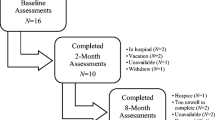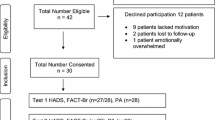Abstract
Purpose
The impact of exercise on health-related quality of life (HRQOL) in patients with glioma remains unknown. We hypothesized that glioma patients with low exercise tolerance experience more distress in HRQOL sleep and fatigue domains than patients with high tolerance to exercise.
Methods
Thirty-eight male and female patients with low- or high-grade glioma treated at a single tertiary care institution participated. Patients completed a validated telephone survey to determine their exercise habits before and following diagnosis. An unpaired t-test was run to measure the interaction between exercise tolerances on HRQOL functional and impairment domains.
Results
Those with low pre-morbid physical activity levels had more distress in HRQOL sleep and fatigue domains. The effects were independent of plasma brain-derived neurotrophic factor (BDNF) levels and the degree of exercise did not appear to impact plasma BDNF in adult glioma patients.
Conclusions
The aim of this study was to examine the significance of exercise habits on perioperative functional outcomes in patients with low-grade or high-grade glioma. We found that glioma patients with low tolerance to exercise had more sleep disturbances and greater fatigue than glioma patients with high tolerance to exercise. Furthermore, exercise tolerance in the adult glioma population does not appear to impact plasma BDNF secretion.


Similar content being viewed by others
Data availability
Available upon request.
Code availability
Not applicable.
References
Ceccarelli M, Barthel FP, Malta TM, Sabedot TS, Salama SR, Murray BA et al (2016) Molecular profiling reveals biologically discrete subsets and pathways of progression in diffuse glioma. Cell 164:550–563
Peters KB, West MJ, Hornsby WE, Waner E, Coan AD, McSherry F, Herndon JE, Friedman HS, Desjardins A, Jones LW (2014) Impact of health-related quality of life and fatigue on survival of recurrent high-grade glioma patients. J Neurooncol 120(3):499–506
Taphoorn MJ, Henriksson R, Bottomley A, Cloughesy T, Wick W, Mason WP et al (2015) Health-related quality of life in a randomized Phase III study of bevacizumab, temozolomide, and radiotherapy in newly diagnosed glioblastoma. J Clin Oncol 33:2166–2175
Smith JS, Chang EF, Lamborn KR, Chang SM, Prados MD, Cha S et al (2008) Role of extent of resection in the long-term outcome of low-grade hemispheric gliomas. J Clin Oncol 26:1338–1345
Lu VM, Phan K, Rovin RA (2018) Comparison of operative outcomes of eloquent glioma resection performed under awake versus general anesthesia: a systematic review and meta-analysis. Clin Neurol Neurosurg 1(169):121–127
Kelm A, Sollmann N, Ille S, Meyer B, Ringel F, Krieg SM (2017) resection of gliomas with and without neuropsychological support during awake craniotomy—effects on surgery and clinical Outcome. Front Oncol 18(7):176
Gabel N, Altshuler DB, Brezzell A, Briceño EM, Boileau NR, Miklja Z, Kluin K, Ferguson T, McMurray K, Wang L, Smith SR (2019) Health related quality of life in adult low and high-grade glioma patients using the national institutes of health patient reported outcomes measurement information system (PROMIS) and neuro-QOL assessments. Front Neurol 15(10):212
Spencer J, Staffileno BA (2021) Exercise Intervention: A Pilot Study to Assess the Feasibility and Impact on Cancer-Related Fatigue and Quality of Life Among Patients With High-Grade Glioma. Clin J Oncol Nurs 25(2):194–200
Williams PT (2014) Reduced risk of brain cancer mortality from walking and running. Med Sci Sports Exerc 46(5):927–932
Sleiman SF, Henry J, Al-Haddad R, El Hayek L, Abou Haidar E, Stringer T et al (2016) Exercise promotes the expression of brain derived neurotrophic factor (BDNF) through the action of the ketone body beta-hydroxybutyrate. Elife 2:e15092
Kleim JA, Chan S, Pringle E, Schallert K, Procaccio V, Jimenez R et al (2006) BDNF val66met polymorphism is associated with modified experience-dependent plasticity in human motor cortex. Nat Neurosci 9:735–737
Altshuler DB, Wang L, Zhao L, Miklja Z, Linzey J, Brezzell A, Kakaizada S, Krishna S, Orringer DA, Briceño EM, Gabel N (2019) BDNF, COMT, and DRD2 polymorphisms and ability to return to work in adult patients with low-and high-grade glioma. Neurooncol Pract 6(5):375–385
Gehring K, Kloek CJ, Aaronson NK, Janssen KW, Jones LW, Sitskoorn MM, Stuiver MM (2018) Feasibility of a home-based exercise intervention with remote guidance for patients with stable grade II and III gliomas: a pilot randomized controlled trial. Clin Rehabil 32(3):352–366
Culos-Reed SN, Leach HJ, Capozzi LC, Easaw J, Eves N, Millet GY (2017) Exercise preferences and associations between fitness parameters, physical activity, and quality of life in high-grade glioma patients. Support Care Cancer 25(4):1237–1246
Cordier D, Gerber M, Brand S (2019) Effects of two types of exercise training on psychological well-being, sleep, quality of life and physical fitness in patients with high-grade glioma (WHO III and IV): study protocol for a randomized controlled trial. Cancer Commun 39(1):1
Midtgaard J, Baadsgaard MT, Moller T, Rasmussen B, Quist M, Andersen C et al (2009) Self-reported physical activity behaviour; exercise motivation and information among Danish adult cancer patients undergoing chemotherapy. Eur J Oncol Nurs 13:116–121
Romero MM, Flood LS, Gasiewicz NK, Rovin R, Conklin S (2015) Validation of the National Institutes of Health Patient-Reported Outcomes Measurement Information System survey as a quality-of-life instrument for patients with malignant brain tumors and their caregivers. Nurs Clin North Am 50:679–690
Cotman CW, Berchtold NC (2002) Exercise: a behavioral intervention to enhance brain health and plasticity. Trends Neurosci 25:295–301
Castelli L, Elter T, Wolf F, Watson M, Schenk A, Steindorf K, Bloch W, Hallek M, Joisten N, Zimmer P (2021) Sleep problems and their interaction with physical activity and fatigue in hematological cancer patients during onset of high dose chemotherapy. Support Care Cancer. https://doi.org/10.21203/rs.3.rs-267117/v1
Buckner JC, Shaw EG, Pugh SL, Chakravarti A, Gilbert MR, Barger GR et al (2016) Radiation plus procarbazine, CCNU, and vincristine in low-grade glioma. N Engl J Med 374:1344–1355
Armstrong TS, Shade MY, Breton G, Gilbert MR, Mahajan A, Scheurer ME, Vera E, Berger AM (2017) Sleep-wake disturbance in patients with brain tumors. Neuro Oncol 19(3):323–335
Fitzpatrick TR, Edgar L, Holcroft C (2012) Assessing the relationship between physical fitness activities, cognitive health, and quality of life among older cancer survivors. J Psychosoc Oncol 30:556–572
Zimmer P, Baumann FT, Oberste M, Wright P, Garthe A, Schenk A et al (2016) Effects of exercise interventions and physical activity behavior on cancer related cognitive impairments: a systematic review. Biomed Res Int 2016:1820954
Jones LW, Guill B, Keir ST, Carter BSK, Friedman HS, Bigner DD et al (2006) Patterns of exercise across the cancer trajectory in brain tumor patients. Cancer 106:2224–2232
Roveda E, Bruno E, Galasso L, Mulè A, Castelli L, Villarini A, Caumo A, Esposito F, Montaruli A, Pasanisi P (2019) Rest-activity circadian rhythm in breast cancer survivors at 5 years after the primary diagnosis. Chronobiol Int 36(8):1156–1165
Galasso L, Montaruli A, Mulè A, Castelli L, Bruno E, Pasanisi P, Caumo A, Esposito F, Roveda E (2020) Rest-activity rhythm in breast cancer survivors: an update based on non-parametric indices. Chronobiol Int 37(6):946–951
Savard J, Morin CM (2001) Insomnia in the context of cancer: a review of a neglected problem. J Clin Oncol 19:895–908
Vaynman S, Gomez-Pinilla F (2005) License to run: exercise impacts functional plasticity in the intact and injured central nervous system by using neurotrophins. Neurorehabil Neural Repair 19:283–295
Laske C, Stransky E, Leyhe T, Eschweiler GW, Wittorf A, Richartz E et al (2006) Stage-dependent BDNF serum concentrations in Alzheimer’s disease. J Neural Transm 113:1217–1224
Barbosa AG, Pratesi R, Paz GS, Dos Santos MA, Uenishi RH, Nakano EY, Gandolfi L, Pratesi CB (2020) Assessment of BDNF serum levels as a diagnostic marker in children with autism spectrum disorder. Sci Rep 10(1):1–7
Pollock GS, Vernon E, Forbes ME, Yan Q, Ma YT, Hsieh T, Robichon R, Frost DO, Johnson JE (2001) Effects of early visual experience and diurnal rhythms on BDNF mRNA and protein levels in the visual system, hippocampus, and cerebellum. J Neurosci 21(11):3923–3931
Caspersen CJ, Powell KE, Christenson GM (1985) Physical activity, exercise, and physical fitness: definitions and distinctions for health-related research. Public Health Rep 100:126–131
Patel AV, Friedenreich CM, Moore SC, Hayes SC, Silver JK, Campbell KL, Winters-Stone K, Gerber LH, George SM, Fulton JE, Denlinger C (2019) American College of Sports Medicine roundtable report on physical activity, sedentary behavior, and cancer prevention and control. Med Sci Sports Exerc 51(11):2391
Funding
Robert Wood Johnson Foundation, Alfred Taubman Medical Research Institute.
Author information
Authors and Affiliations
Contributions
All authors contributed to the manuscript, including writing and development.
Corresponding author
Ethics declarations
Ethics approval
Approved by institutional review board, HUM00092238.
Consent to participate
All participants provided written consent to participate.
Conflict of interest
The authors declare no competing interests.
Additional information
Publisher's note
Springer Nature remains neutral with regard to jurisdictional claims in published maps and institutional affiliations.
Zachary Miklja and Nicolette Gabel are co-first authors.
Shawn L. Hervey-Jumper and Sean Smith co-senior authors.
Rights and permissions
About this article
Cite this article
Miklja, Z., Gabel, N., Altshuler, D. et al. Exercise improves health-related quality of life sleep and fatigue domains in adult high- and low-grade glioma patients. Support Care Cancer 30, 1493–1500 (2022). https://doi.org/10.1007/s00520-021-06566-2
Received:
Accepted:
Published:
Issue Date:
DOI: https://doi.org/10.1007/s00520-021-06566-2




